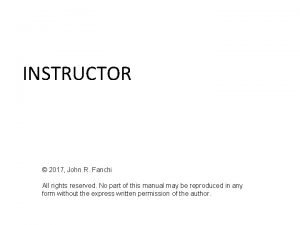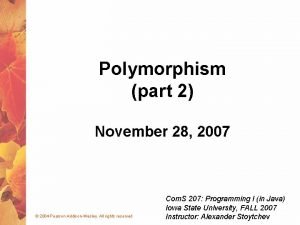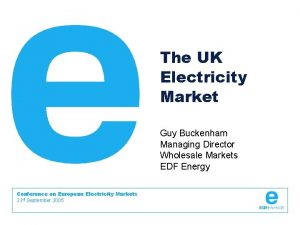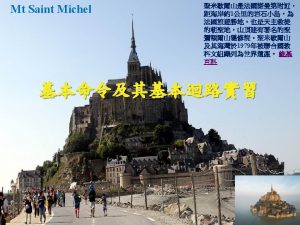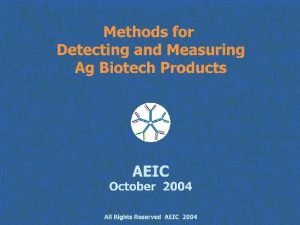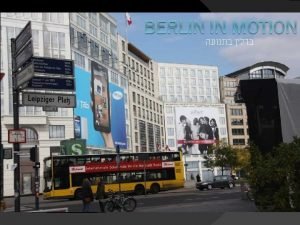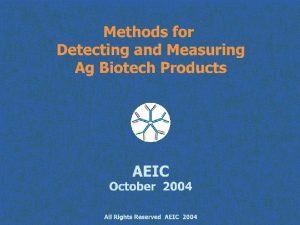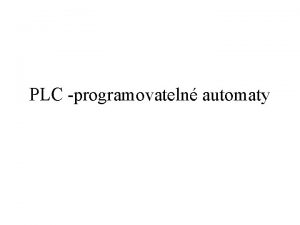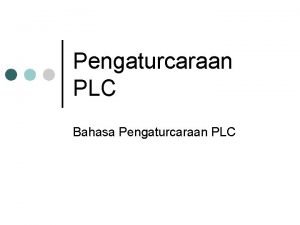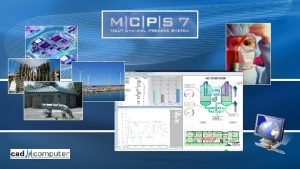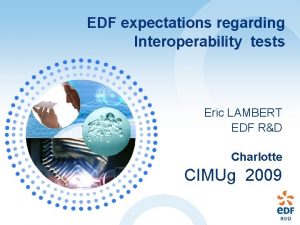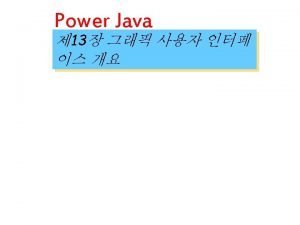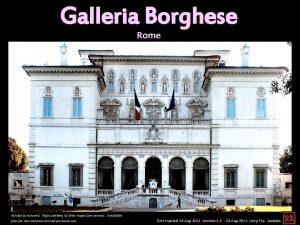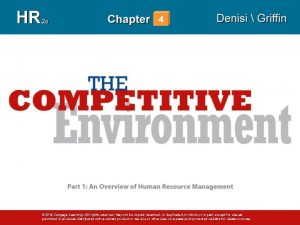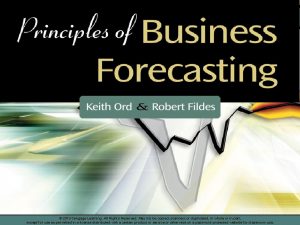1 EDF Energy plc All rights Reserved NOT








































- Slides: 40

1 EDF Energy plc. All rights Reserved NOT PROTECTIVELY MARKED

Nuclear Reactor Operational Experience 25 th April 2017 Speaker: Simon Wright BEng (Hons) AMIMech. E EDF Energy Design Engineering Heysham 1 Power Station 2 EDF Energy plc. All rights Reserved NOT PROTECTIVELY MARKED

EDF Energy is the UK’s largest producer of lowcarbon electricity, meeting around one-fifth of the country’s demand supplying millions of customers and businesses with electricity and gas. • Generating electricity with eight nuclear power stations, more than 30 wind farms, one gas and two coal power stations, as well as with combined heat and power plants • Provides about half of the UK’s low carbon electricity • Employs around 13, 000 people across England Scotland • Supplies electricity and gas to more than 5 million business and residential customers, making us the biggest supplier of electricity by volume in Britain • EDF Energy is leading the UK's nuclear renaissance with the construction of a new nuclear power station at Hinkley Point C. This will provide low carbon electricity to meet 7% of UK demand EDF Energy plc. All rights Reserved NOT PROTECTIVELY MARKED EDF Energy is a wholly owned subsidiary of EDF Group which is listed on the Paris Stock Exchange and is a member of the CAC 40 index EDF Group is the leading electricity producer in Europe and has over 37 million customers worldwide

Title of Presentation © 1 January 2014 EDF Energy plc. All rights Reserved NOT PROTECTIVELY MARKED/PROTECT – (use descriptor)/OFFICIAL EDF Energy plc. All rights Reserved NOT PROTECTIVELY MARKED 4 SENSITIVE BEG/FORM/COMM/026 B Rev 008

Our nuclear plants in the UK We own and operate two types of nuclear reactor in the UK • advanced gas-cooled reactor (AGR • pressurised water reactor (PWR) Seven of our nuclear power stations (14 of our reactors) are of the AGR design, whilst Sizewell B is a PWR We also have offices in Barnwood and East Kilbride, London and other locations around the UK In 2016, our nuclear power stations generated 65. 1 TWh low carbon electricity - enough to supply about 50% of UK homes EDF Energy plc. All rights Reserved NOT PROTECTIVELY MARKED

History of Nuclear Power in the UK • Calder Hall in 1956 - First Civil Nuclear Programme - Duel Commercial and Military Role - Four Magnox Reactors (more on Magnox later) • Windscale 1962 (WAGR) - 2 nd generation prototype reactor - More on AGR later - Now used to demonstrate safe decommissioning of Nuclear Reactors 6 EDF Energy plc. All rights Reserved NOT PROTECTIVELY MARKED

Timeline 1947 - UK’s first nuclear reactor was built at Atomic Energy Research Establishment (AERE) Harwell to demonstrate the viability of commercial power reactors. 1956 – 1959 Calder Hall 1 -4 connected to the grid - World’s first commercial nuclear reactor, Calder Hall 1 (MWe net: 50) at Windscale (later Sellafield) is opened by Queen Elizabeth II. 1962 -1971 - Nine Full Scale Magnox Power Stations Open 1971 - British Nuclear Fuels Limited (BNFL) established after demerger of UKAEA. 1976 - 1988 - Seven Advanced Gas Cooled Reactors (AGR’s) are built to replace Magnox, owned and operated by Ed. F 7

Timeline 1979 - Three Mile Island Incident resulting in the formation of INPO 1986 - Chernobyl Incident resulting in the formation of WANO 1988 - Construction of Sizewell B begins, the first PWR in the UK 1989 - Magnox reactors are withdrawn from electricity privatisation. The city refuses to buy the older stations because of decommissioning costs and the taxpayer is left with the bill. 1995 - Sizewell B (MWe net: 1188) connected to grid after lengthy 7 year construction and public enquiry and is such the last nuclear reactor built to date in the UK. 8

Timeline Late-1990 s - Nuclear energy in the UK is at a peak, contributing around 25% of the UK’s energy needs. 2005 - The government's chief scientific adviser, Sir David King, voices his support for a nuclear power revival, saying there are economic as well as environmental reasons for a new generation of reactors. 2006 - Tony Blair says nuclear power is once again a serious option 2007 - New prime minister, Gordon Brown, calls for an acceleration of nuclear power in a speech to business leaders. 2008 - UK Government gives the go-ahead for a new generation of nuclear power station to be built - French energy giant EDF Finalises a £ 12. 4 bn deal to buy British Energy which runs eight nuclear sites with land on which new reactors could be built. 9

Timeline 2009 - £ 12. 5 billion acquisition of British Energy by EDF was completed. - Centrica, announces a deal with EDF that will involve it in building new nuclear power stations in the UK. 2011 - Nuclear energy supplying around 19% of UK energy needs. - Despite local opposition, officials give the go-ahead for work to begin on Hinkley C in Somerset, the first new nuclear power station for 20 years. 2013 - Hinkley Point C given approval with predicted power generation for 5 million homes. Expected to generate 25, 000 jobs during construction and 900 permanent jobs during operation. 2015 -2016 - Plant Lifetime Extension business cases approved for Hinkley, Hunterston, Heysham 1, Hartlepool, Heysham 2 and Torness 2016 - Hinkley Point C Construction commences expected to be operational by 2025 10

Types of Nuclear Reactors in the UK fleet • There are 3 main types of Nuclear Reactor in the UK: - Magnox 1 st Generation - Advanced Gas-cooled Reactor 2 nd Generation - Pressurised Water Reactor 3 rd Generation 11 EDF Energy plc. All rights Reserved NOT PROTECTIVELY MARKED

Types of Nuclear Reactors in the UK fleet • Magnox (Magnesium non-oxidising) - Fuel: Magnesium Alloy used to clad the fuel rods - Moderator: Graphite - Coolant: Carbon Dioxide - Temp Limitations - Reacts with water 12 EDF Energy plc. All rights Reserved NOT PROTECTIVELY MARKED

Types of Nuclear Reactors in the UK fleet • Advanced Gas-Cooled Reactor (AGR) - 2 nd Generation Nuclear Reactor - Majority of the UK Fleet (14 in total) - Two reactors in a single building - 1500 MWt - 660 MWe Turbo-Generator Set 13 EDF Energy plc. All rights Reserved NOT PROTECTIVELY MARKED

Types of Nuclear Reactors in the UK fleet • Advanced Gas-Cooled Reactor (AGR) Benefits: - Higher fuel temperatures (648 Deg C Outlet) - Superheater outlet 170 bar and 543 Deg C - Higher temperatures, better steam conditions, higher cycle efficiency - Re-entrant gas flow acts as a core coolant, similar temperatures to Magnox - St St Fuel clad has a higher neutron capture cross section requiring enriched uranium fuel - Higher burn ups and less frequent refuelling 14 EDF Energy plc. All rights Reserved NOT PROTECTIVELY MARKED

Types of Nuclear Reactors in the UK fleet • Pressurised Water Reactor (PWR) : - Primary Coolant Water pressurised to 155 bar at 275 Deg C - Zircalloy Clad, Enriched Uranium - Much smaller and simpler in design - Off Power Refuelling, reactor needs dismantling to refuel - Sizewell B (Westinghouse Design) - Nuclear New Build (Hinkley Point C) is a Europen Pressurised Reactor (EPR by Areva). Currently under construction in Finland, France and China 15 EDF Energy plc. All rights Reserved NOT PROTECTIVELY MARKED

Typical Power Station Layout • A Nuclear Power Station layout is very similar to a conventional power station - We use Boilers to convert Water into Steam - We use Steam to rotate a Turbo generator at 3000 rpm to generate Electricity • The clever bit is how we heat the Feed Water using a Nuclear Reactor 16 EDF Energy plc. All rights Reserved NOT PROTECTIVELY MARKED

AGR Power Production Schematic Steam Carbon dioxide 17 Shaft Feedwater cleaning & heating EDF Energy plc. All rights Reserved NOT PROTECTIVELY MARKED To the consumer Water Warm Cold Filter water Sea

18 EDF Energy plc. All rights Reserved NOT PROTECTIVELY MARKED

Components of an AGR • Fuel - Enriched Uranium-235, fissile material can sustain a chain reaction and is naturally occurring • Moderator - Mostly Graphite – Low neutron absorption, High thermal conductivity, Low Thermal Expansion 19 EDF Energy plc. All rights Reserved NOT PROTECTIVELY MARKED

Components of an AGR • Coolant - Carbon Dioxide – Good Heat Transfer, Low Neutron Absorption, inexpensive, Low viscosity (easier to circulate) • Control - Auto/Coarse Control Rods • Containment – Pressure vessel 20 EDF Energy plc. All rights Reserved NOT PROTECTIVELY MARKED

What fuel do we use at Heysham power stations? 21 EDF Energy plc. All rights Reserved NOT PROTECTIVELY MARKED

Uranium fuel • The raw material used to create fuel for nuclear power stations is Uranium ore. • Uranium is not a rare metal – it is about as abundant as tin and can even be found in seawater. • Around 60% the Uranium mined in the world is taken from mines in Australia, Canada and Kazakhstan • Turning it into nuclear fuel requires special processes 22 EDF Energy plc. All rights Reserved NOT PROTECTIVELY MARKED

Natural Uranium U-238 99. 3% U-235 0. 7% 23 EDF Energy plc. All rights Reserved NOT PROTECTIVELY MARKED

Enrichment 0. 7% U-235 Centrifuges 99. 3% U-238 3. 0% U-235 97. 0% U-238 Fuel Pellet Length 15 mm, Diameter 15 mm & Bore 5 mm 24 EDF Energy plc. All rights Reserved NOT PROTECTIVELY MARKED

Nuclear fission 25 EDF Energy plc. All rights Reserved NOT PROTECTIVELY MARKED

Fuel fabrication The enriched Uranium is converted into black Uranium Dioxide (UO 2) powder which is compressed and baked into ceramic fuel pellets. In an AGR, the pellets are encased in metal tubes called fuel pins. A collection of fuel pins is called a fuel element 26 EDF Energy plc. All rights Reserved NOT PROTECTIVELY MARKED

Moderator • Graphite was chosen as the material for the reactor core as it is an excellent moderator • The process of slowing down the neutrons is achieved using a moderator 27 EDF Energy plc. All rights Reserved NOT PROTECTIVELY MARKED

• Super Critical - neutron population increasing - thermal power increasing • Critical - neutron population constant - thermal power constant • Sub-Critical - neutron population decreasing - thermal power falling 28 EDF Energy plc. All rights Reserved NOT PROTECTIVELY MARKED

Reactivity Control using Control Rods. How do we What happens when stop power we want to raise from power? continuing to Critical Position Rods Raised (Higher Power) (Low Power) or Lowered (Reactor rise? as required Super-critical) Reactor Trip (All Rods fully inserted) What happens on trip? How do we stabilize Power? 29 EDF Energy plc. All rights Reserved NOT PROTECTIVELY MARKED

Control Rods • Overview - Control Reactor Power by controlling growth of neutron population is achieved by adding a neutron absorber into the core - Control rods are raised an lowered to vary the amount of neutron absorber acting inside the core - Regulate the reactor power output - Shutdown the Reactor - Maintain the shutdown condition - Control reactor channel gas temperature 30 EDF Energy plc. All rights Reserved NOT PROTECTIVELY MARKED

Control Rods • Two Types Typically: - Black/Shutdown/Bulk boron steel rods that are very strong neutron absorbers - normally kept outside the core used to Trip or shutdown the reactor - Grey/Control/Trim rods stainless steel (Boron inserts) rods moved in or out as required. • 81 in total (44 Coarse and 37 Auto) 31 EDF Energy plc. All rights Reserved NOT PROTECTIVELY MARKED

The Fuel Route 35 EDF Energy plc. All rights Reserved NOT PROTECTIVELY MARKED

What makes nuclear different? • When a gas fired power station is shut down the heat dissipates quite quickly. • We have nuclear fuel (enriched uranium) in our reactors • Heat continues to be generated when a nuclear power station is shut down (Decay Heat) and must continue to be cooled – this requires off site power supplies, water supplies and cooling water from the sea (CW). EDF Energy plc. All rights Reserved NOT PROTECTIVELY MARKED

What happens to the used fuel? • • Used fuel is highly radioactive and gives off a lot of heat. Initially spent fuel stored on-site - In special ponds to allow the radioactivity and heat to decrease - The water acts as a barrier against radiation and disperses the heat - The longer it is stored, the easier it is to handle The used fuel is then either reprocessed to recover the usable portion or sent for long term storage or disposal Spent fuel from the AGRs is sent to Sellafield for reprocessing or safe storage 37 EDF Energy plc. All rights Reserved NOT PROTECTIVELY MARKED

Irradiated fuel, transferred in flasks • Operation Smash Hit Video 38 EDF Energy plc. All rights Reserved NOT PROTECTIVELY MARKED

Regulation of Nuclear Generation in UK Internal Regulation EDF Energy plc. All rights Reserved NOT PROTECTIVELY MARKED

Proposed designs for the UK are EPRs • The EPR is a pressurised water reactor (like Sizewell B in Suffolk) • Same design as EDF’s Flamanville project in France • 2 reactors with each reactor capable of supplying around 2. 5 million homes • 1 new EPR will provide as much electricity as Heysham 1 & 2 combined • 4 reactors over two sites (Hinkley and Sizewell) would meet roughly 12% of UK electricity demand • Thousands of construction jobs over nearly a decade • Over 700 permanent jobs once both plants are operating • Uses 17% less uranium and produces less waste EDF Energy plc. All rights Reserved NOT PROTECTIVELY MARKED Cutaway of a single EPR

Decommissioning Overview / Background • UK legislation relating to the decommissioning of nuclear power plants, embodied in Cm 2919, requires that “…. all nuclear operators draw up strategies for decommissioning their redundant plant…” In response to this requirement, EDF Energy have formulated a corporate decommissioning strategy, corporate decommissioning plan and site-specific baseline decommissioning plans • EDF Energy and its precursor organisations developed what became a decommissioning strategy with a common strand. This common strand involved some form of Safestore to allow a deferral of reactor dismantling, thus allowing for radioactive decay of the reactor structures and materials. • Decommissioning Timescales are long – circa 100 yrs for AGR • The NLF is underpinned by Government- any shortfall met by Government (UK taxpayer) • The AGR decommissioning strategy is termed Early Safestore (ESS) • AGR Decommissioning Strategy of Early Safestore (ESS) where the term “early” refers to the fact that construction of the safestore for implementation of period of care and maintenance is instigated as soon as is reasonably practicable after End of Generation (e. o. g). EDF Energy plc. All rights Reserved NOT PROTECTIVELY MARKED 41

AGR Decommissioning Strategy – Early Safestore e. g. Hinkley Point B Current Site Layout Preparatory Work 2020 Plant Dismantling Complete Defuelling, Plant & Building Dismantling, Waste Management & Safestore Construction 2023 Site Surveillance 2033 Site Layout During Surveillance 42 Safestore Construction Complete Reactor Dismantling in Progress Site Cleared for Re-use Care & Maintenance Site Re-establishment, Reactor & Reactor Building Dismantling, Site Monitoring & Clearance 2108 2118 EDF Energy plc. All rights Reserved NOT PROTECTIVELY MARKED

44 EDF Energy plc. All rights Reserved NOT PROTECTIVELY MARKED
 All rights reserved example
All rights reserved example Copyright 2015 all rights reserved
Copyright 2015 all rights reserved All rights reserved sentence
All rights reserved sentence Creative commons vs all rights reserved
Creative commons vs all rights reserved Confidential all rights reserved
Confidential all rights reserved Sentinel value
Sentinel value Copyright © 2015 all rights reserved
Copyright © 2015 all rights reserved 2012 pearson education inc
2012 pearson education inc Microsoft corporation. all rights reserved.
Microsoft corporation. all rights reserved. Microsoft corporation. all rights reserved
Microsoft corporation. all rights reserved Microsoft corporation. all rights reserved
Microsoft corporation. all rights reserved Pearson education inc. all rights reserved
Pearson education inc. all rights reserved Dell all rights reserved copyright 2009
Dell all rights reserved copyright 2009 Warning all rights reserved
Warning all rights reserved Siprop
Siprop Quadratic equation cengage
Quadratic equation cengage Warning all rights reserved
Warning all rights reserved Confidential all rights reserved
Confidential all rights reserved Microsoft corporation. all rights reserved
Microsoft corporation. all rights reserved 2010 pearson education inc
2010 pearson education inc Copyright © 2018 all rights reserved
Copyright © 2018 all rights reserved Gssllc
Gssllc Pearson education inc all rights reserved
Pearson education inc all rights reserved 2010 pearson education inc
2010 pearson education inc Confidential all rights reserved
Confidential all rights reserved Confidential all rights reserved
Confidential all rights reserved R rights reserved
R rights reserved Rights reserved
Rights reserved Edf
Edf Positive vs negative rights
Positive vs negative rights Difference between littoral and riparian rights
Difference between littoral and riparian rights Moral duties
Moral duties Legal rights and moral rights
Legal rights and moral rights Positive and negative rights
Positive and negative rights Negative right
Negative right Positive vs negative rights
Positive vs negative rights Positive rights and negative rights
Positive rights and negative rights Vocabulary workshop level d unit 1
Vocabulary workshop level d unit 1 Love is not all analysis
Love is not all analysis Name 3 points
Name 3 points Guy buckenham edf
Guy buckenham edf


























